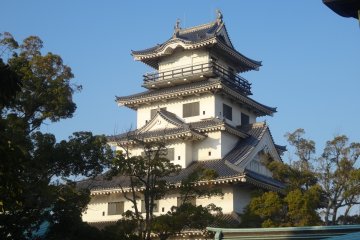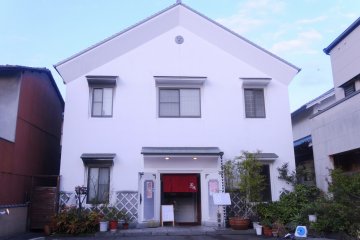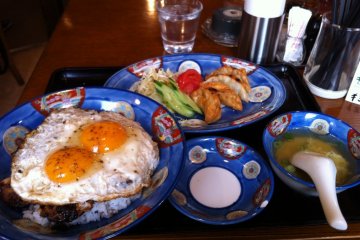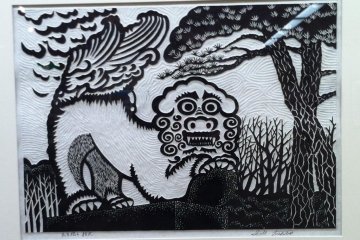
Imabari Castle by Day
AnonymousImabari Castle is one of the obvious landmarks of the city of Imabari. It’s a very pretty castle, surrounded by a square moat of seawater.

Protruding from a concrete landscape—one of the tallest things in sight—is Imabari Castle, in the coastal city of the same name. This structure is one of three Mizujiro, or “castles on the sea,” in Japan. Construction began in 1602 under the local feudal lord and eminent designer of castles Todo Takatora.
In 1635, Matsudaira Sadafusa, the nephew of the famous shogun Tokugawa Ieyasu, became the owner; Imabari’s position near the Seto Inland Sea provided a strategic advantage for controlling maritime traffic. With the Meiji Restoration, however, the Matsudairas fell out of power and many of the buildings on the compound were disassembled. In 1980, the city rebuilt the tenshu, or keep, out of concrete and ever since has been erecting old buildings loyal to original techniques and materials.
Nowadays Imabari Castle is noted for its seawater moat (it stands right by a port), which, centuries before, would have protected against arrows and other weapons. The keep has five layers and six stories, offering wonderful views of both city and sea, as well as the Kurushima Kaikyo Bridge. Picturesque view aside, the castle itself warrants close scrutiny. From dusk to 11 p.m., illuminations cast a warm glow on the white walls and multicolored stone. If you look for long enough, you can see large fish jumping out of the moat.
Inside are numerous artifacts detailing the feudal history of the area, including suits of armor that belonged to the feudal lords, clothing, weapons and art. A smaller gallery even touches on the natural history of Imabari, exhibiting stuffed animals and fossils. Also on the grounds is a magnificent statue of the designer Todo Takatora on horseback, as well as an air raid siren erected during wartime. For ¥500, visitors can view the exhibits or even explore the Shinto shrine on site.
A 10-minute taxi ride from Imabari Station.

Imabari Castle is one of the obvious landmarks of the city of Imabari. It’s a very pretty castle, surrounded by a square moat of seawater.

Imabari Castle is one of Japan's only seaside castles, and a beautiful place to pass a spring afternoon.

Classy comfort can be found at the Imabari Kokusai Hotel in northern Ehime Prefecture.

Near the port in Imabari (今治市, Imabari-shi) is a huge, beautifully made ship’s propeller displayed as sculpture. It looks like a giant flower. In front of it are the words “Zo-sen no machi, Imabari” or “Shipbuilding town, Imabari”. This is the theme of the city, and even in the swanky Imabari Kokusai Hotel, large, scale models of the ships made in Imabari are displayed on every floor. Unfortunately, the Koreans have found ways to make ships more cheaply. Today, Imabari is on the ropes, and it shows. One of the features of Imabari is its arcades and commercial district arranged in a regular grid. Many of the buildings are old, and they speak of the city’s past vigour. Sadly, lots of them are now shuttered and in disrepair due to the slump in shipbuilding. Nonetheless, others are still thriving, and working hard to offer valuable products at good prices. One that will appeal particularly to foreign visitors is the souvenir and kimono shop Gofukuten Sugataya. Among these streets, there’s a great deal of old-time architectural charm from the Showa period and earlier, with signs painted in font faces not often seen anymore. In the covered arcades, many of the shops have a very 1960s feel, giving the impression of a timeslip. Besides shipbuilding, the industries of Imabari include tiles, towels, and fishing, and these are much in evidence in one form or another. Imabari has many temples dotted among its residential and commercial premises, and the roofs of these temples are decorated in particularly fine style with long dragons along the gables. The city has had a huge Towel Museum for many years featuring the design possibilities of towels, and after conducting a branding exercise, these designs are now finding their way into attractive specialist towel shops in the city. I own a couple of towel scarves made in Imabari, and they’re a wonderful multipurpose accessory for the stylish, active man. Imabari is also known for its condiments for meats, many of which are produced at Nihon Shokken’s monstrous baroque factory, an outsize replica of the Belvedere Palace in Vienna. Factory tours and tastings are available. Imabari Castle is one of the obvious landmarks of the city. It’s a very pretty castle, surrounded by a square moat of seawater, with fish that frequently jump out of the water. Dating originally from 1604, the castle keep was ordered destroyed in the Meiji period, and the current tower was built in 1980. It’s well worth a visit for its beauty, its views, and the fine collection of armor, weapons, and artworks on display. The coast around Imabari is very attractive, and the beaches along the Seto Inland Sea are good for swimming. They’re characterized by orangey-yellow sand, backed with picturesque pines that give off a pleasant scent in the heat of summer. Imabari is the second largest city in Ehime prefecture. Following a recent merger, the city has an estimated population of 172,384. It’s serviced by Imabari Station on the JR Shikoku system. This is a main station on the Yosan line with limited express service. The city is also home to a ferry terminal, which acts as a hub for many of the ferry systems that link the nearby smaller islands. Imabari is home to six of the temples of the Shikoku Pilgrimage, from 54 to 59. These are Enmeiji, Nankobo, Taisanji, Eifukuji, Senyuji, and Kokubunji. For eats in Imabari, besides the many fish dishes that are common throughout Ehime, visitors are urged to try the ‘yakibuta tamago meshi’, a concoction of seasoned pork with lightly fried eggs on rice, with a sweet, peppery sauce. Of these, Shigematsu Hanten is probably my favourite. Imabari is linked to Hiroshima prefecture by the Shimanami Kaido, a series of bridges linking several of the islands of the Inland Sea.

Imabari Station Hotel is a budget hotel located conveniently close to Imabari railway station.

Kurazen provides tasty Japanese izakaya dishes in a traditional-style warehouse building near Imabari Castle.

Redo Herb & Asian Café is a haven for spicy food just behind Imabari harbour.

Hakurakuten is well known for its yaki-buta-tamago-meshi, a specialty of Imabari. But fans of this dish believe that there are better places to enjoy it.

There is no better way to see the Kurushima Kaikyo Bridge and its stretch of the Seto Inland Sea than from the top of Mount Kiro, at the southernmost point of Oshima island. On particularly clear days, the spectacular view extends to the jagged summit of Ishizushi, the largest mountain in western Japan, and was named one of the 88 best sceneries in Shikoku. The observatory park on Mount Kiro was designed by Pritzker Architecture Prize-winner Kengo Kuma; the sleek, metallic observation point goes nicely with the surrounding flora, which is preserved to maintain the natural beauty of the site. The numerous stairwells and decks make for a 360-degree view of the sea, which is especially breathtaking at sunset, as the distant mountain ranges fade to blue and a warm-toned sky is reflected on the water. At night, the bridge is illuminated. In spring, the forested region of this panoramic view is dotted with cherry blossoms. It’s possible that you’re biking since the park is only a few minutes away from the Shimanami Expressway, a popular and famously well-organized cycling route that spans several islands, including Oshima. Getting to the summit involves a steep ride and many steps, but the view is well worth it, not to mention the public restroom facility and kiosk.

The Imabari City Kono Museum of Art is an old-school Japanese art gallery. It has a fine collection of screens and scrolls, and hosts regular special exhibitions.

Gofukuten Sugataya and Gallery Kazahaya stands on a street corner marked by a beautiful weeping willow that provides a lively contrast with the black and white building behind it. This shop sells kimono and associated goods, as well as fabrics, socks, slippers, handkerchiefs, postcards, accessories, basketry and many other items, all displayed beautifully. In general, the prices are surprisingly affordable.